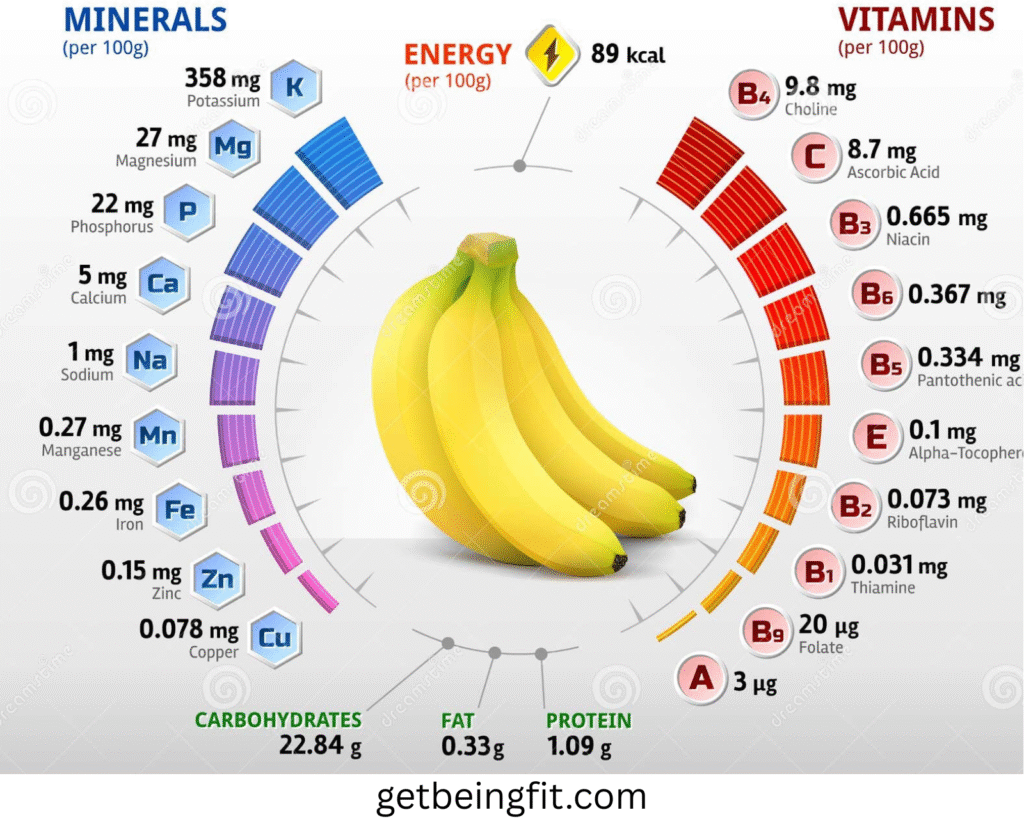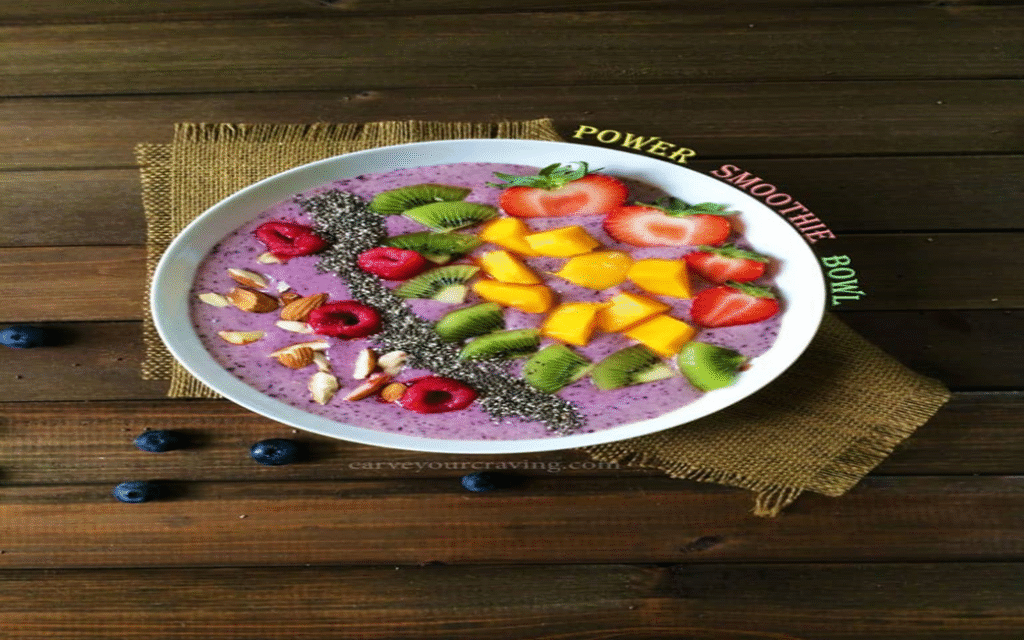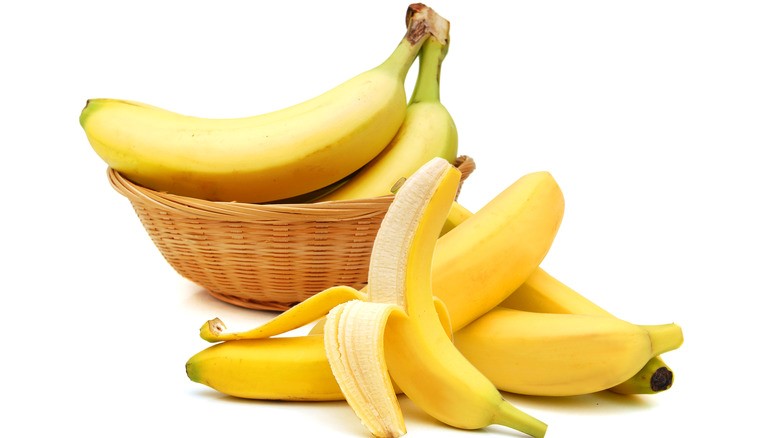Discover why bananas(Banana Bliss) are more than just a snack—uncover their hidden health benefits, risks, and 5 delicious recipes (including a nutrition chart!). Perfect for fitness lovers, busy moms, and foodies!
Introduction
Bananas are the world’s most popular fruit, celebrated not only for their natural sweetness and convenience but also for their impressive versatility in health and culinary uses. From serving as a natural energy bar for athletes to being a secret ingredient in skincare routines, bananas have something for everyone. In this deep dive guide, we’ll explore:
- Banana Nutrition Facts: Detailed calorie, carb, and vitamin breakdown for a medium banana—presented with an easy-to-read comparison chart.
- Science-Backed Health Benefits: How bananas boost heart health, mood, and aid post-workout recovery.
- 5 Surprising Banana Recipes: Innovative sweet and savory dishes that go beyond your typical smoothie.
- The Dark Side: Important information on when bananas might harm your health.
- Tips for Buying & Storing: Learn how to select the perfect bananas and maximize their shelf life.

1. Banana Nutrition Facts: What’s Inside?
Bananas(Unbeatable Nutrition) pack a powerful nutrient punch in a naturally portable package. For instance, a single medium banana (approximately 118 grams) contains essential vitamins and minerals that contribute to overall well-being. Below is a detailed nutrition chart showing the breakdown of key nutrients per medium banana:
| Nutrient | Amount (per medium, 118g) | % Daily Value* |
|---|---|---|
| Calories | 105 | 5% |
| Carbohydrates | 27g | 9% |
| Fiber | 3g | 12% |
| Potassium | 422mg | 12% |
| Vitamin C | 10mg | 11% |
| Magnesium | 32mg | 8% |
*Based on a 2,000-calorie diet. (Image Suggestion: An infographic chart comparing banana nutrition with apples and oranges. Alt Text: “Banana Nutrition Chart: Calories, Carbs, Fiber, Potassium & More”)
Key Compounds
- Resistant Starch: Acts as a prebiotic that feeds your gut bacteria, supporting digestive health.
- Dopamine: Although bananas do not contain dopamine that crosses the blood-brain barrier, they help boost mood by increasing serotonin levels.
- Vitamin B6: Essential for brain development and function, and helps maintain healthy nerve cells.
Bananas are an excellent source of energy and vital nutrients that many athletes, busy professionals, and families rely on daily.
2. Banana Health Benefits: More Than Just Potassium!
Bananas are widely praised for more than their potassium content. Scientific studies and practical observations have confirmed a range of health benefits that extend to different aspects of wellbeing:
A. Heart Health Hero
- Potassium Power: Bananas are rich in potassium, which is essential for maintaining optimal blood pressure levels and heart function. Studies have shown that a potassium-rich diet can lower the risk of heart disease and stroke.
- Fiber Benefits: The dietary fiber in bananas helps reduce LDL (bad) cholesterol levels, promoting overall cardiovascular health.
B. Natural Energy Booster
- Quick Energy Source: With easily digestible carbohydrates, bananas provide an instant energy boost without the crash associated with refined sugars.
- Perfect Pre-Workout Snack: Combine bananas with almond butter or a handful of nuts for a balanced mix of carbs and protein, ideal for sustained energy during workouts.
C. Sleep Aid and Mood Enhancer
- Magnesium for Relaxation: The magnesium in bananas helps relax muscles and prevent nighttime cramps, making them a great pre-bedtime snack.
- Happy Hormones: Bananas stimulate the production of serotonin and dopamine, which can improve mood and help manage stress.
D. Supports Digestion
- Soluble Fiber: Helps maintain regular bowel movements and supports a healthy gut microbiome.
- Digestive Enzymes: The natural enzymes in bananas can aid in the digestion of carbohydrates and proteins.
(Image Suggestion:
3. The Dark Side of Bananas: Who Should Exercise Caution?
Despite their numerous benefits, bananas are not without potential drawbacks. It’s important to understand when and for whom bananas might not be the ideal choice:
A. High Sugar Content
- Sugar Levels: Overripe bananas contain higher amounts of natural sugars, which can lead to a rapid spike in blood glucose. While this is not an issue for most people, diabetics or those on a strict low-sugar diet should opt for slightly green bananas or consume them in moderation.
B. Migraine Trigger
- Tyramine Effects: Ripe bananas contain tyramine, which in some susceptible individuals may trigger headaches or migraines. If you’re prone to migraines, monitor your banana intake and note any correlations.
C. Potential Risks for Kidney Patients
- Excess Potassium: For individuals with kidney disease, excess potassium can be harmful. These individuals should consult their healthcare provider about the suitable daily amount of bananas.
D. Bloating and Digestive Discomfort
- High Fiber & Sorbitol Content: For those with sensitive stomachs, the combination of fiber and naturally occurring sugar alcohol (sorbitol) can sometimes cause bloating or digestive discomfort if consumed in large quantities.
Safe Daily Intake: For most adults, one to two bananas per day is considered a healthy serving.
(Image Suggestion: A caution graphic featuring a banana with red alert symbols and caution icons. Alt Text: “Banana Caution: High Sugar, Migraines & Kidney Risks”)
4. 5 Banana Recipes You’ve Never Tried (Sweet & Savory!)
Bananas aren’t just for eating raw or adding to smoothies—they are a versatile ingredient in the kitchen. Here are five surprising recipes that transform bananas into culinary masterpieces:
Recipe 1: 3-Ingredient “Nice Cream”
Ingredients:
- 2 frozen bananas (ripe and peeled)
- 1 tablespoon cocoa powder (unsweetened)
- A splash of almond milk (or any plant-based milk)
Steps:
- Combine all ingredients in a blender.
- Blend until you achieve a smooth, creamy texture.
- Scoop into a bowl and top with fresh berries or chopped nuts for added crunch.
Health Hack: No added sugar—just pure, naturally sweet delight!
(Image Suggestion: Step-by-step images of the Nice Cream process. Alt Text: “3-Ingredient Banana Nice Cream Recipe”)
Recipe 2: Banana Peel Curry (Zero Waste Delight)
Ingredients:
- 2 banana peels (organic and thoroughly washed)
- 1 large onion, finely chopped
- 1 medium tomato, chopped
- Curry spices (turmeric, cumin, coriander, and chili powder)
- Salt and pepper to taste
Steps:
- Sauté the onions in a little oil until translucent.
- Add the chopped banana peels and tomatoes.
- Season with curry spices, salt, and pepper.
- Cook on medium heat until the peels soften and absorb the spices.
Pro Tip: Banana peels are rich in antioxidants and fiber—reduce waste while enjoying unique flavors.
(Image Suggestion: A vibrant photo carousel showcasing each step of Banana Peel Curry preparation. Alt Text: “Banana Peel Curry Recipe: Eco-Friendly & Delicious”)
Recipe 3: Banana Oat Pancakes
Ingredients:
- 1 ripe banana, mashed
- 1 cup rolled oats
- 1 egg (or flax egg for a vegan option)
- 1/2 teaspoon baking powder
- A pinch of salt
- 1/4 cup milk (dairy or plant-based)
Steps:
- In a bowl, mix the mashed banana with the egg and milk.
- Stir in the oats, baking powder, and salt.
- Pour small amounts of the batter onto a hot, lightly oiled skillet.
- Cook until bubbles form, then flip and cook the other side until golden brown.
Taste Tip: Top with a dollop of Greek yogurt and fresh fruit for a nutritious breakfast.
(Image Suggestion: A beautifully plated stack of banana oat pancakes drizzled with honey. Alt Text: “Healthy Banana Oat Pancakes Recipe”)
Recipe 4: Spicy Banana Chutney
Ingredients:
- 2 ripe bananas, diced
- 1 small red chili, finely chopped
- 1 tablespoon ginger, grated
- 1 tablespoon lemon juice
- Salt to taste
- Fresh coriander leaves, chopped
Steps:
- In a mixing bowl, combine the diced bananas, chili, and grated ginger.
- Stir in lemon juice and salt.
- Garnish with chopped coriander leaves.
- Serve as a tangy side or a topping for grilled meats and veggie wraps.
Flavor Twist: The spice of the chili contrasts beautifully with the natural sweetness of bananas for a unique flavor boost.
(Image Suggestion: A serving bowl of spicy banana chutney with vibrant garnishes. Alt Text: “Spicy Banana Chutney Recipe for an Unexpected Flavor Kick”)
Recipe 5: Banana Smoothie Power Bowl
Ingredients:
- 1 frozen banana
- 1/2 cup frozen mixed berries
- 1/2 cup spinach
- 1 cup almond milk
- 1 tablespoon chia seeds
Steps:
- Blend the frozen banana, mixed berries, spinach, and almond milk until smooth.
- Pour the smoothie into a bowl.
- Top with chia seeds, sliced banana, and a handful of granola for texture and crunch.
Booster Tip: This power bowl is perfect as a post-workout meal packed with antioxidants and essential nutrients.

5. How to Buy & Store Bananas Like a Pro
Choosing the right bananas not only enhances taste but also ensures that you get maximum nutritional benefits. Here are some expert tips:
Buying Guidelines
- Choose Greenish-Yellow Bananas: If you plan to consume them later in the week, opt for bananas that are still slightly green. This slows down the ripening process.
- Check for Bruises: Avoid bananas with dark spots or bruises if you intend to use them for cooking or in salads.
- Ethical Sourcing: Look for brands with Fair Trade or Rainforest Alliance certifications. Supporting ethical practices can make your snack even more satisfying.
Storage Tips
- Room Temperature: Store bananas at room temperature to allow them to ripen naturally.
- Separation: Keep bananas separate from other fruits if you want to slow down ripening (bananas emit ethylene, which can speed up the process for other produce).
- Freezing: For smoothies or baking, peel and freeze overripe bananas in a sealed bag. They’ll blend seamlessly when you need an energy boost.
(Image Suggestion: A labeled infographic showing bananas at different stages—from green to yellow to brown—with storage tips. Alt Text: “How to Buy & Store Bananas: Ripeness Guide and Pro Tips”)
Conclusion
Bananas truly are nature’s multitasker—a nutrient-packed superfood that offers a range of benefits from boosting heart health and energy levels to serving as a versatile ingredient in both sweet and savory dishes. Whether you’re an athlete reaching for a pre-workout snack, a busy mom preparing quick recipes, or a foodie eager to explore new culinary ideas, bananas can elevate your diet without sacrificing flavor. Remember, moderation is essential, and understanding both the benefits and potential downsides will help you incorporate bananas into your diet safely and deliciously.
By following our comprehensive guide—with detailed nutrition facts, science-backed health benefits, creative recipes, and expert storage tips—you can make informed decisions that suit your lifestyle and optimize your health. Embrace the power of bananas and turn this everyday fruit into your kitchen’s next superstar!
Frequently Asked Questions (FAQs)
- Are bananas good for weight loss? Yes! Their high fiber content can help keep you full longer, contributing to a balanced diet. However, it’s best to stick to one to two bananas daily.
- Can diabetics eat bananas? Diabetics should choose slightly green bananas due to their lower glycemic index, and pairing them with a protein source (like nuts) can further stabilize blood sugar levels.
- Do banana peels have any uses? Absolutely. Besides being used in innovative recipes like banana peel curry, they can be repurposed for natural cleaning, composting, or even as a beauty treatment for polishing silver.
- What causes bananas to make you bloat? The combination of high fiber and sorbitol found naturally in bananas may cause bloating in individuals with sensitive digestive systems.
- How many bananas should I eat per day? For most people, one to two bananas daily is a healthy serving. Those with kidney concerns or diabetes should adjust their intake accordingly and consult a healthcare provider if necessary.


